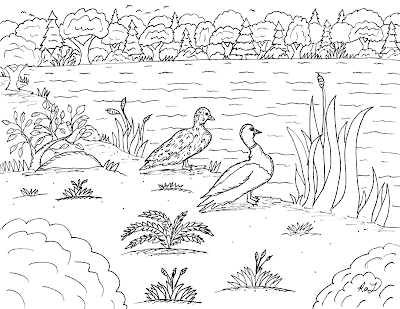Mallard Ducks are a very common and successful species of duck that are native to several continents. It lives in temperate and subtropical climates of North America, Europe, Asia, and North Africa. It has also been introduced in several other countries including: New Zealand, Australia, Brazil, Uruguay, Peru, Argentina, Columbia, Chile, and South Africa. They also were introduced successfully in the Falkland Islands.
Males or drakes have a beautiful green or glossy green head and grayish bodies. The females or hens have brown speckled feathers all over their bodies.. that speckling gives them great camouflage in reeds and grasses where they nest. Males have the bright colors to attract the females. It is probably a liability as far as any hiding from predators, but Nature has its ways of sacrificing camo for cute. Both drakes and hens have speculum feathers that are white, blue and black on a small part of their wings. The wingspan is around 32-39 inches or 81-98 cm. Males or drakes can weigh up to 3.5 lbs or 1.58 kg. Many Mallards will migrate to warmer temperatures in the winter. Some will stay around city ponds or areas with water access and become part of a local flock. When migrating in the winter the North American Mallards have been seen in the Carribean Islands, Mexico, and North America.
Mallards are called dabbling ducks. That means that they graze on plants by upending on the water's surface and eating what they can get at. They rarely dive deep. This is also how swan and geese feed. Many swan and geese also migrate like Mallard Ducks. Swan, geese and ducks often fly in a V formation and take turns at the point or front. This helps avoid fatigue or one leader getting too tired flying up front of the flock.
Mallard Ducks
(This is the only NEW drawing on this post.)
In the drawing the male is up front closer to the foreground and the female is further away. Remember, the female is brown-ish and that head on the male is a beautiful glossy green.
Swan realistic
Canadian Geese
By the way, some people have speculated that duckbill dinosaurs or hadrosaurs may have had a similar affinity for water as ducks, swans, and geese. Dinosaurs, or at least most of them, lived on land most of the time, but many, like duckbill dinos probably could swim well. So being a dinosaur nut that I am I am adding a drawing of a Parasaurolophus that is swimming. By the way, ducks did NOT evolve form hadrosaurs. The modern birds are sometimes called avian dinosaurs or avian theropods. Ducks and all birds are indeed dinosaurs, but they evolved from the theropod or meat eating dinos. As a dino-nut from a young age, I THOUGHT that duckbills or hadrosaurs evolved into ducks. This is not true. Kind of confusing, huh?
ONE more thing: The duck bill on both hadrosaurs and ducks is an example of convergent evolution ....which is where a trait evolves independently in animals that are completely unrelated. Another example is how dolphins and sharks are shaped very much alike, even though they are not related.
Parasaurolophus Swimming Lessons
Notice the duck bill on this hadrosaur or duckbill dino.

















































